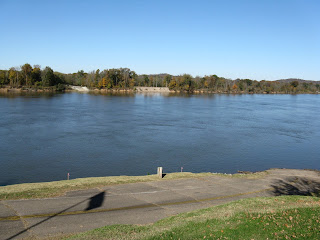 Another example of the rock formations on the Tennessee is this bluff several miles south of Chattanooga.
Another example of the rock formations on the Tennessee is this bluff several miles south of Chattanooga. We stayed at a floating city dock right on the Chattanooga waterfront. We had enough time the first day to go through the Tennessee Aquarium. This is a modern first class aquarium. It has many walk through exhibits and the largest fresh water aquarium tank in the US.
 Along with the fish tanks were displays of other animals that live on the water. The alligator exhibit had these little ones.
Along with the fish tanks were displays of other animals that live on the water. The alligator exhibit had these little ones.There was a variety of beautiful ducks.

The next day we took the free downtown electric shuttle bus out to the Chattanooga Choo Choo. This is name for the the 1908 Southern RR Terminal Station that has been converted into a hotel and entertainment facility. The railroad station had its last passenger train in 1970.
The inside of the terminal has a domed ceiling. Built of steel and concrete and buttressed by huge brick arches, the dome rested on four steel supports 75 feet apart. Inside this waiting area passengers waited for the 50 different trains at the peak of train travel.
Inside one of the old railway freight buildings was an HO scale model railroad covering 174 feet long 33 feet wide. It depicted Chattanooga and the surrounding Cumberland mountain area. It includes over 3,000 feet of track, 320 structures, 150 switches, 120 locomotives of all types, 1,000 freight cars and 80 passenger cars.
The Chattanooga Choo Choo was a Southern Railway passenger train that ran from Cincinnati through Chattanooga which first began in 1880. This wood burning steam locomotive was similar to the type used in 1880.
 The electric bus took us back downtown. The city has a variety of unusual benches set up around the downtown. This one had ceramic insets set up with an animal scene.
The electric bus took us back downtown. The city has a variety of unusual benches set up around the downtown. This one had ceramic insets set up with an animal scene. We took a walk up the hill to the Hunter Art Museum. It is a modern building adjoining a 1904 Victorian mansion owned by the first Coca-Cola bottler in the nation. Art is displayed in both buildings.
We took a walk up the hill to the Hunter Art Museum. It is a modern building adjoining a 1904 Victorian mansion owned by the first Coca-Cola bottler in the nation. Art is displayed in both buildings.There is a walking bridge over to the museum. It has glass floors so you can look down and see the cars on the street about 100 feet below. Its a weird feeling.


Some of the tourist locations required that we take a city bus out several miles. We caught the bus for Route 15 and the driver dropped us off at the International Towing and Recovery Museum.

Inside were examples of tow trucks .

Then we boarded the Route 15 bus an hour later and took it to the Incline Railway stop. This car pictured makes the climb up the side of Lookout Mountain. It climbs a grade of up to a 70% incline.

As the car reaches the top the slope is steep enough that you have to look out the top of the car to see the valley below.


This is the Point Park at the top of Lookout Mountain. During the Civil War the Confederates held this ground overlooking the Union troops that were trapped in Chattanooga. As part of the campaign by U.S. Grant to relieve the siege of Chattanooga, he ordered an attack on Lookout Mountain. In the famous "Battle Above the Clouds", Union units captured the Confederate positions below the summit forcing the Confederates to withdraw. This NY Regiment monument at the top commemorates this successful assault.
The view that the Confederates had of Chattanooga from Lookout Mountain. The Tennessee River curves around a peninsula (on the left) called Moccasin Point.
The rock formations on top of Lookout Mountain are distinctive. There are Civil War photos of troops arrayed around many of the formations near the top.
The Delta Queen steernwheeler no longer travels the rivers but is anchored to the bank and serves as a hotel. Chatanooga has a "Duck" tour of the downtown and waterfront. It shows in the foreground.
We left the city dock after three nights to head upriver. Unfortunately, as we reached the Chickamauga Lock we were told by the lockmaster that the lock was closed due to high water. So we turned around and headed back to the city dock for 2-1/2 more days.














































